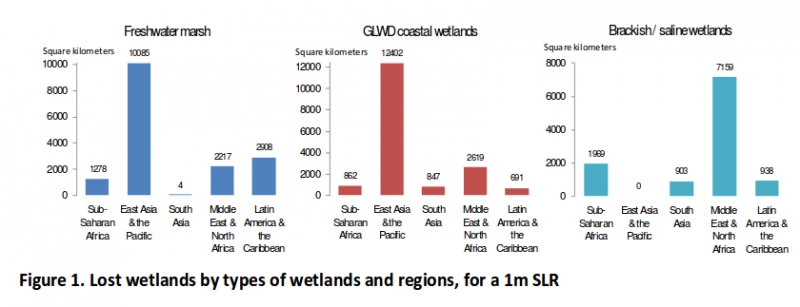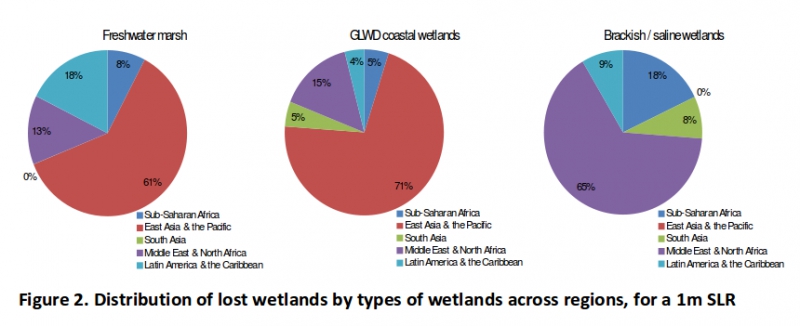Coastal Wetlands under threat from Sea Level Rise says World Bank

The World Bank study looked at the risk to coastal wetlands in 76 countries at a sea level rise of one metre. Because there are so many uncertainties with the rate of sea level rise, the one metre level was chosen to study the likely impact. This sea level may be achieved this century, with sea level rising 60% faster than IPCC projections. Sea level rise is unstoppable, but it can be slowed through emissions reduction and give us humans and ecosystems a chance to adapt. Sea levels will continue to rise for several centuries.
The study found that about 99% of the coastal wetlands at elevations of one meter or less in the Middle East and North Africa could disappear, as well as 77% in sub-Saharan Africa, 66% in East Asia and 39% in Latin America and the Caribbean. Places like the iconic Sundarbans of Bangladesh and India, a major home and refuge to the Bengal tiger, are under threat.
Coastal fresh-water marshes would be particularly affected in Argentina, China, Iran, Mexico and Vietnam. Up to 61% of Saltwater wetlands would be affected in Egypt and Libya.
"The findings are alarming, because wetlands don't exist just for the birds and plants - people rely on them for water, food, transportation, and other essential goods and services," says Susmita Dasgupta, a lead environment economist at the Bank's Development Research Group. She co-authored the study with colleague Brian Blankespoor and consultant Benoit Laplante. "We hope our research can motivate steps to protect wetlands, especially since global warming will for sure accelerate the rise of sea levels."
Coastal wetlands ecosystems over the last century have been vanishing due to land development. Wetlands have suffered through drainage for agriculture, dredging for better navigation, conversion to aquaculture and fish farming, discharge of pesticides, herbicides & nutrients and a host of other changes. It is projected that increasing sea levels from climate change will have an increasing impact surpassing the destruction of human land use changes.
Coastal wetlands provide many valuable ecosystem services. These include protection of shorelines from erosion, storm buffering, sediment retention, water quality maintenance, nutrient recycling, preservation of biodiversity, provision of natural environmental amenities, climate regulation, carbon sequestration, as well as cultural heritage. But with urban development and land use change Coastal ecosystems suffer 100 fold decrease in capacity to store carbon mitigating climate change.
With sea level rise wetlands to survive will need to migrate inland. But they will face numerous competition and obstacles from the human built world. But different wetland environments will have different migratory potential. Brackish and freshwater marshes will be most affected in the coastal zone through alteration of hydrological regimes. Saltmarshes may do better as they accrete vertically and maintain their elevation relative to sea level where the supply of sediment is sufficient. According to the report swamp forests appear less vulnerable to sea level rise.
Indeed, as species attempt to migrate inland they will increase competition with human land use and existing ecosystems. It will produce a secondary impact of sea level rise on habitat loss and species biodiversity, which has largely been unassessed in most modelling and planning.
"In terms of area estimates, this would translate to a loss of 16,492 square kilometre of freshwater marsh, 17,421 square kilometre of GLWD Coastal Wetlands and 10,969 square kilometre of saline wetlands. Among the four coastal wetland categories, only swamp forests appear less vulnerable to SLR and more capable of migrating as the coast line is receding...." says the report.
From the report: Table 2: Expected loss of wetlands in square kilometres by types of wetlands for most impacted countries (with expected percent loss in parenthesis)
| Rank | Freshwater Marsh | Lakes and Coastal wetlands | Saline Wetlands |
|---|---|---|---|
| 1 | Vietnam 8,583 sqkm (65%) | China 9,810 sqkm (76%) | Libya 3,725 sqkm (100%) |
| 2 | Argentina 1,335 sqkm (100%) | Myanmar 1,922 sqkm (56%) | Egypt 2,914 sqkm (100%) |
| 3 | Iran 1,256 sqkm (100%) | Egypt 1,433 sqkm (100%) | Mauritania 1,947 sqkm (100%) |
| 4 | China 751 sqkm (91%) | Iran 704 sqkm (87%) | India 889 sqkm (13%) |
| 5 | Mexico 745 sqkm (100%) | India 669 sqkm (84%) | Argentina 745 sqkm (100%) |
| 6 | Brazil 601 sqkm (61%) | Mauritania 430 sqkm (100%) | Tunisia 235 sqkm (100%) |
| 7 | Egypt 538 sqkm (100%) | Mexico 415 sqkm (100%) | Morocco 208 sqkm (100%) |
| 8 | Benin 412 sqkm (100%) | Tunisia 368 sqkm (100%) | Peru 90 sqkm (100%) |
| 9 | Senegal 368 sqkm (96%) | Indonesia 287 sqkm (53%) | Dominican Republic 80 sqkm (100%) |
| 10 | Papua New Guinea 337 sqkm (84%) | Philippines 229 sqkm (100%) | Republic of Yemen 77 sqkm (100%) |
The report concludes:
"Our estimates indicate that for a 1 m SLR, approximately 64% of the freshwater marsh, 66% of GLWD Coastal Wetlands, and 61% of brackish/saline wetlands in 76 developing countries are at risk. The economic value of the annual flow of goods and services produced by these wetlands has been estimated, crudely but we believe conservatively, to be approximately $ 630 million (in 2000 US dollars). The most striking feature of our results is the extreme concentration of effects in a handful of countries. Our findings indicate that a large percentage of this loss would take place in East Asia and the Pacific, and the Middle East and North Africa. In Asia, China, and VietNam bear the brunt of these losses. In the Middle East and North Africa, Libya and Egypt experience most losses (saline wetlands)."
The remote sensing and mapping had difficulty with resolution to pick up the impact on many Pacific Islands. One of the very concerning features of this report is the amount of freshwater and coastal wetlands in East Asia and the Pacific under threat. Much of this is in Vietnam and China, but many Pacific island nations will also be strongly impacted. In fact, at a sea level rise of 1 metre some low-lying nations are likely to no longer exist; their population and culture having to migrate elsewhere to survive. The wetland mangrove ecosystems on these islands will surcomb to the rising seas.
Sources:
- World Bank media release, 1 March 2013, Coastal Wetlands Highly Vulnerable to Sea-Level Rise
- Blankespoor, Brian; Dasgupta, Susmita; Laplante, Benoit; 1 November 2012, Sea-level rise and coastal wetlands : impacts and costs (abstract), World Bank Policy Research working paper ; no. WPS 6277
- Graphic images from Blankespoor et al.
Get Involved
If you'd like to help with maintaining or developing the website, contact us.
Publish
Publish your stories and upcoming events on Indybay.




